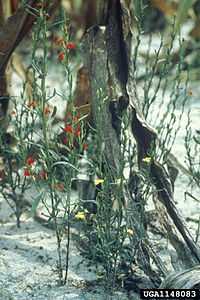Striga asiatica
| Asiatic witchweed | |
|---|---|
 | |
| Scientific classification | |
| Kingdom: | Plantae |
| (unranked): | Angiosperms |
| (unranked): | Eudicots |
| (unranked): | Asterids |
| Order: | Lamiales |
| Family: | Orobanchaceae |
| Genus: | Striga |
| Species: | S. asiatica |
| Binomial name | |
| Striga asiatica (L.) Kuntze | |
| Synonyms | |
|
Striga lutea | |
Asiatic witchweed (Striga asiatica) is a hemiparasitic plant in the broomrape family. It is native to Asia and sub-Saharan Africa,[1] but has been introduced into other parts of the world including Australia and the United States. Witchweed is a serious agricultural pest as it parasitises important crop species, including corn, rice, sorghum, and sugar cane, often causing substantial yield reductions.[2]
In the USA, witchweed was discovered in the Carolinas in 1955. It is considered an invasive agricultural pest, and a vigorous eradication campaign has reduced the affected area by 99% [from 450,000 acres (1,820 km2) to about 3,400 acres (14 km2)].[3]
Biological control can be achieved by growing a Desmodium (tick-trefoil) undercrop (see push–pull technology). The trefoil can be used as green manure or animal fodder after the harvest.
References
- ↑ Cochrane, V., Malcolm C. Press (1997). "Geographical Distribution and Aspects of the Ecology of the Hemiparasitic Angiosperm Striga asiatica (L.) Kuntze: A Herbarium Study". Journal of Tropical Ecology 13 (3): 371–380. doi:10.1017/S0266467400010579. JSTOR 2560290.
- ↑ USDA
- ↑ Global Invasive Species Database
Sources
- Invasive.org
- "Striga asiatica". Integrated Taxonomic Information System.
- Simberloff, Daniel. 2003. Eradication - preventing invasions at the outset. Weed Science 51:247–253.
- Striga asiatica in Brunken, U., Schmidt, M., Dressler, S., Janssen, T., Thombiano, A. & Zizka, G. 2008. West African plants - A Photo Guide. Forschungsinstitut Senckenberg, Frankfurt/Main.
External links
- Species Profile- Witchweed (Striga asiatica), National Invasive Species Information Center, United States National Agricultural Library. Lists general information and resources for Witchweed.
See also
- Striga (plant)